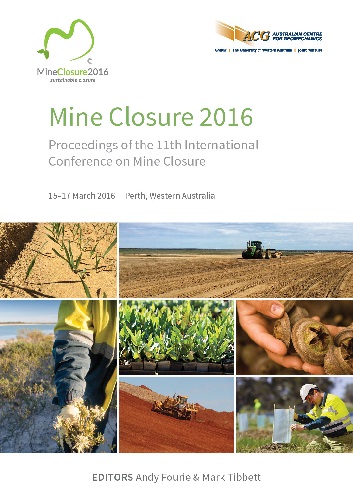Dealing with mine closure planning liabilities, opportunities and lessons learned

|
Authors: Dagva, MB; Davaatseren, Ts; Vladimir, Kh |
DOI https://doi.org/10.36487/ACG_rep/1608_27_Dagva
Cite As:
Dagva, MB, Davaatseren, Ts & Vladimir, Kh 2016, 'Dealing with mine closure planning liabilities, opportunities and lessons learned', in AB Fourie & M Tibbett (eds), Mine Closure 2016: Proceedings of the 11th International Conference on Mine Closure, Australian Centre for Geomechanics, Perth, pp. 381-388, https://doi.org/10.36487/ACG_rep/1608_27_Dagva
Abstract:
In 1978, Erdenet Mining Corporation (EMC or Erdenet) was established in accordance with a joint venture agreement between the governments of Mongolia and the former Soviet Union (51% and 49%, respectively). As one of the largest ore mining and processing operations in the world, the company produces approximately 530,000 tonnes of copper concentrate and 4,500 tonnes of molybdenum concentrates annually. The company plans to expand its productivity from 26 mtpa to 32 mtpa due to declining ore grade, to retain competiveness and also to hold revenue at a consistent level. Consequently, a number of issues became apparent that were not identified in the decision-making process for the expansion approval. What was initially thought to be a gradual process of developing and integrating mine closure plans (MCP) for the mine operations over the life-of-mine, this expansion now requires a MCP for the decommissioning of the old tailings storage facility (TSF) and a MCP incorporated into the design of the new TSF. This paper examines a number of issues and opportunities that accompany expansion changes to a 37 year old mine. Firstly, the MCP needs to be integrated into the company’s business plan. A mid term business plan update (2016 to 2025) is in progress. The number of items were determined which were relevant to mine closure within this timespan. For example, the existing TSF is at approximately 60% of its initial design capacity; a new TSF will need to be constructed during the next 10–14 years. The old TSF will require a MCP to deal with drainage and groundwater contamination, existing dust issues, rehabilitation and ongoing monitoring and remediation. By contrast, the new TSF will include mine closure considerations during the design, construction and operation; an ideal opportunity to reduce post-closure monitoring, costs and ongoing liabilities. Erdenet town was established in 1974 specifically for the mine and now has a population of around 110,000. Public participation will be adopted for the first time during the new TSF/MCP development process and for the old TSF closure. This paper will also touch on the changes in town dynamics since the mine’s conception and what this may mean to the mine closure process.
Keywords: Erdenet, mine closure planning, TSF
References:
Dagva, M, Glen, A, Davaatseren, Ts, Vladimir, Kh & Erdenetuya, O 2015, ‘Challenges of integrating mine closure plans mid-way through the life of mine in Mongolia’, in AB Fourie, M Tibbett, L Sawatsky and D van Zyl (eds), Proceedings of the 10th International Conference on Mine Closure, pp. 805–816.
Davies, MP, Lighthall, PC, Rice, S, Martin, TE 2002, ‘Design of Tailings Dams and Impoundments’, Tailings and Mine Waste Practices, SME, AGM, Phoenix.
DME (Department of Minerals and Energy, Western Australia) 1999, Guidelines on the safe design and operating standards for tailings storage, The Government of Western Australia.
MEGD (Mongolian Ministry of Environment and Green Development and Tourism) 2015, Environmental Statistical Database,
© Copyright 2025, Australian Centre for Geomechanics (ACG), The University of Western Australia. All rights reserved.
View copyright/legal information
Please direct any queries or error reports to repository-acg@uwa.edu.au
View copyright/legal information
Please direct any queries or error reports to repository-acg@uwa.edu.au